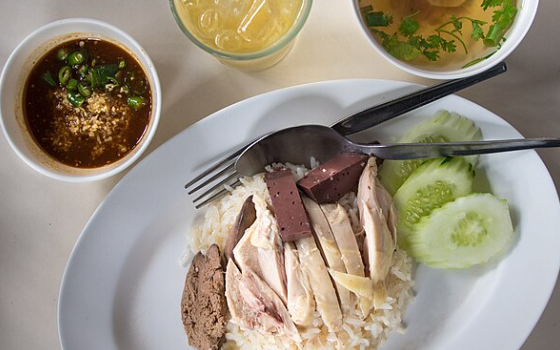
Singapore is widely known as a food lover’s paradise, and it’s easy to see why. With a rich blend of Chinese, Indian, and Malay food cultures, along with influences from all around the world, Singapore offers an incredible range of flavors and dishes that cater to every taste. Whether you’re a fan of mild dishes or enjoy fiery hot curries, this vibrant city has something for everyone. Singaporeans take their food seriously, and it’s no surprise to see even the wealthiest lining up at local hawker stalls for delicious, budget-friendly meals. If you’re planning a visit, here’s our guide to five essential dishes you must try during your stay.
1. Hainanese Chicken Rice
Start your Singapore culinary adventure with Hainanese Chicken Rice—a dish that’s as simple as it is iconic. The chicken is cooked to perfection, offering tender meat with a rich, oily skin and a delicate gelatine layer. Served with rice cooked in chicken broth, it’s accompanied by a dark soy drizzle and a zesty chili dip. Easily found at hawker centres, this dish is a staple of Singaporean cuisine and even regarded as the national dish. Look for the white chickens displayed behind the glass at hawker stands, signaling the freshness of this beloved meal.
2. Singapore Chilli Crab
Though often considered a bit cliché these days, Singapore Chilli Crab is undeniably a must-try. Stir-fried in a tangy, sweet, and spicy tomato-based sauce, the crab is served in its shell, and you’ll need a crab cracker to break into the claws and scoop out the tender meat. Mud crabs are typically used, though you’ll also find various other crab varieties in restaurants around Singapore’s Boat Quay. Despite being a bit pricey, it’s a perfect dish for those looking to indulge while watching the crabs being prepped in the lively atmosphere of this iconic area.
3. Fish Head Curry
Fish Head Curry is a dish that beautifully combines Singapore’s Chinese and Indian culinary influences. This spicy curry, made with the head of a red snapper, includes a rich, soupy sauce filled with vegetables. It’s a unique and flavorful dish that originated when an Indian chef decided to add a fish head to his curry to appeal to Chinese customers. The result was an unforgettable dish that’s now a favorite in Singapore. If you’re not up for the full fish head experience, smaller portions can be found at local hawker stalls, particularly in Little India, where it’s a popular offering.
4. Roti Prata
End your food-filled day with Roti Prata, a beloved dish that’s popular in Singapore’s late-night food scene. This crispy, golden flatbread is often served with spicy curry and is the perfect comfort food after a long day of eating. Though Roti Prata has its roots in India, Singapore has perfected it. For a twist, try Murtabak, a stuffed version of roti with chicken or mutton, or Kottu Roti, where roti is chopped up and mixed with meat and eggs. These dishes are typically served with your right hand, as tradition dictates in the region.
5. Nasi Lemak
A true Singaporean classic, Nasi Lemak is a dish that represents the country’s Malay heritage. This simple but satisfying meal features coconut rice, crispy anchovies (ikan bilis), roasted peanuts, and a spicy sambal sauce made with ground chili, lime, and shrimp paste. Though often enjoyed at breakfast, Nasi Lemak can be found throughout the day and is occasionally wrapped in banana leaves with grilled meats and other delicious accompaniments. It’s an affordable and tasty meal that’s perfect for a quick bite or takeaway.
Singapore’s food scene is one of the most diverse and exciting in the world, offering a wide variety of flavors that cater to every preference. From hawker centres to high-end restaurants, there’s something for everyone. These five dishes—Hainanese Chicken Rice, Chilli Crab, Fish Head Curry, Roti Prata, and Nasi Lemak—are just the beginning of your culinary journey in Singapore, and they’ll give you a true taste of the city’s food culture.




















Comments